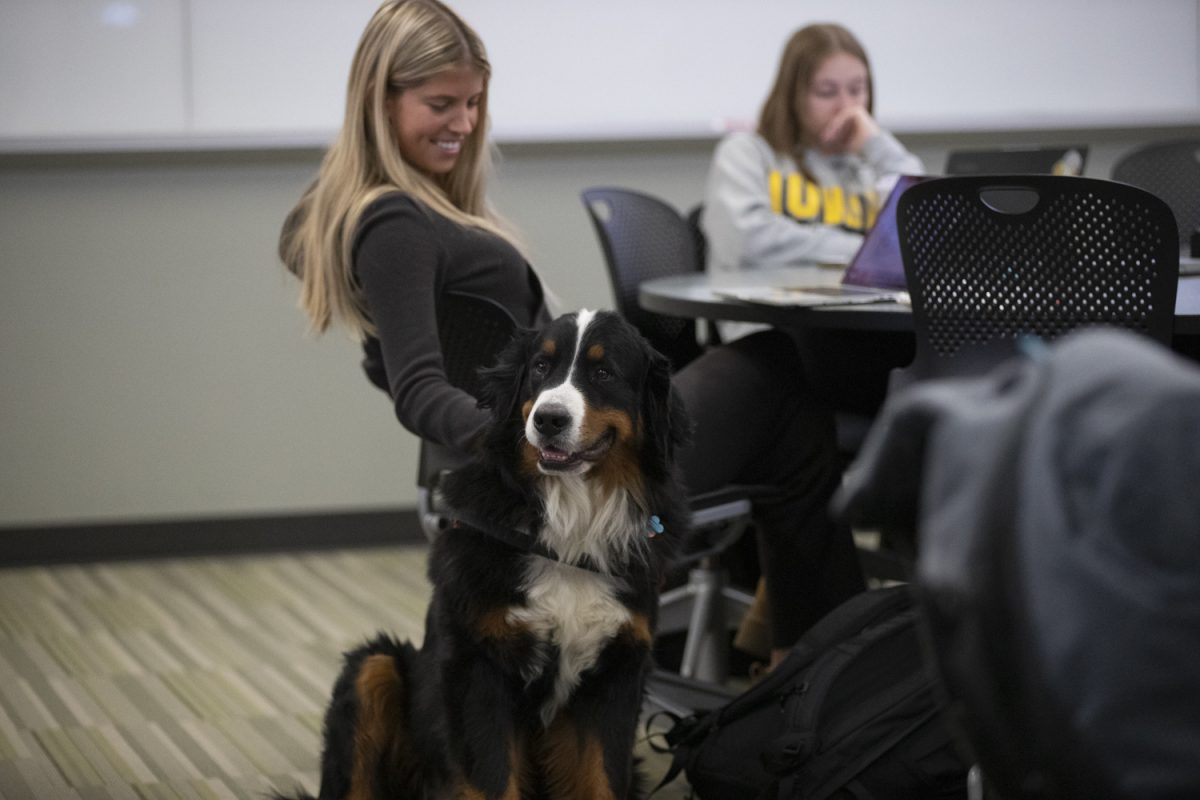At Trowbridge Hall, an academic building on the east side of the University of Iowa’s campus, a new, four-legged staff member, Drax the two-and-a-half-year-old Bernese Mountain Dog, has taken up residence to assist with classes.
Drax joined the UI’s therapeutic recreation and child life programs in August and is just the second therapy dog on campus. The other is Wilkie, a Whoodle that is primarily focused on offering mental health support for students.
In his time at the university, Drax attends classes, assists in lectures at Trowbridge, and holds drop-in office hours in room E206 at the Fieldhouse from 9:30 a.m. to 11:30 a.m. on Wednesdays.
Adrienne Johnson, associate professor of instruction for the therapeutic recreation program, is Drax’s owner and handler. Johnson teaches an animal-assisted therapy course in which Drax offers students real-world experience in working with a therapy animal.
Johnson said the department often brings in certified therapy teams for demonstration in class, so incorporating Drax into the program made sense.
Before engaging in courses at the UI, Drax went through multiple levels of therapy animal training and obtained several certifications, including PetCo’s Canine Good Citizen certificate, and a certification through Pet Partners.
When his litter was born, Drax and his siblings were tested for temperament. Of his litter, Drax was considered the best fit to be a therapy animal. Drax began training shortly after, learning commands and preparing to become a therapy dog.
For the first year and a half of his life, Drax continued through higher levels of training. Johnson said Drax has been in constant training on top of what the pair practice at home.
Drax and Johnson earned certifications through Pet Partners before Drax received approval to work at the university.
It all began when Johnson and her family became interested in adding a dog to the family. Johnson and her husband, who worked in forensic psychology at UI, recognized that both of their fields would benefit from therapy animals and wanted to incorporate it into both their home and work lives.
RELATED: UI hosts dedication for new Veterans Plaza outside Iowa Memorial Union
Johnson was prompted to pursue owning a therapy dog by observing the effects of the COVID-19 pandemic on students’ mental health and the increasing prominence of therapy animals in the therapeutic recreation field.
“We saw the students’ mental health reacting to [the pandemic] and having some difficulties adjusting and then readjusting as we came back into the classroom environment,” she said.
Johnson said she thought bringing a therapy dog into her animal-assisted therapy classes would be an opportunity to bring real-world experience into the classroom, as well as support the learning environment.
Drax’s typical day starts with getting in his morning exercise, which Johnson said helps Drax release energy before class.
In class, Drax greets his students before choosing a comfortable spot to sit and observe. If a student appears to be unfocused, he spends time with them.
Johnson said Drax makes students feel more comfortable, prompting them to engage more frequently in the classroom.
While Drax’s main role is to assist with curriculum and course instruction, Johnson said he also reduces some mental health symptoms students face, such as loneliness, anxiety, or depression.
“That’s not his first purpose, but it’s definitely one that I see coming to the front a lot more often than I anticipated,” Johnson said.
Juliette Joyaux, a UI third-year student studying therapeutic recreation, said students are more engaged when Drax is in class.
“Everyone is a little bit more active in the class, a little bit more engaged than compared to normal,” Joyaux said. “When he’s not there, the energy is definitely on the lower side.”
Joyaux’s family dog passed away about a year ago, and she enjoys having another dog to interact with. She said seeing him in class is an “instant serotonin boost.”
Tessa Bartell, a UI third-year student and president of the Therapeutic Recreation Student Association, said Drax’s presence increases students’ overall mood and well-being in the classroom.
Bartell has taken Johnson’s classes both with and without Drax and said she prefers classes with the furry addition.
While most dogs don’t work a 9 p.m. to 5 p.m., Drax seems to enjoy his job and the role he plays in the classroom. Johnson said Drax always gets excited when he sees his therapy dog vest, indicating that it’s time for him to go to work.
“When I don’t take him, I can tell that he’s not happy with me. On days when he needs to stay back behind for whatever reason, I get the look,” Johnson said. “He hops right in the car as soon as it’s time to go. He’s just been really enjoying coming to work every day too and being a part of the university.”



